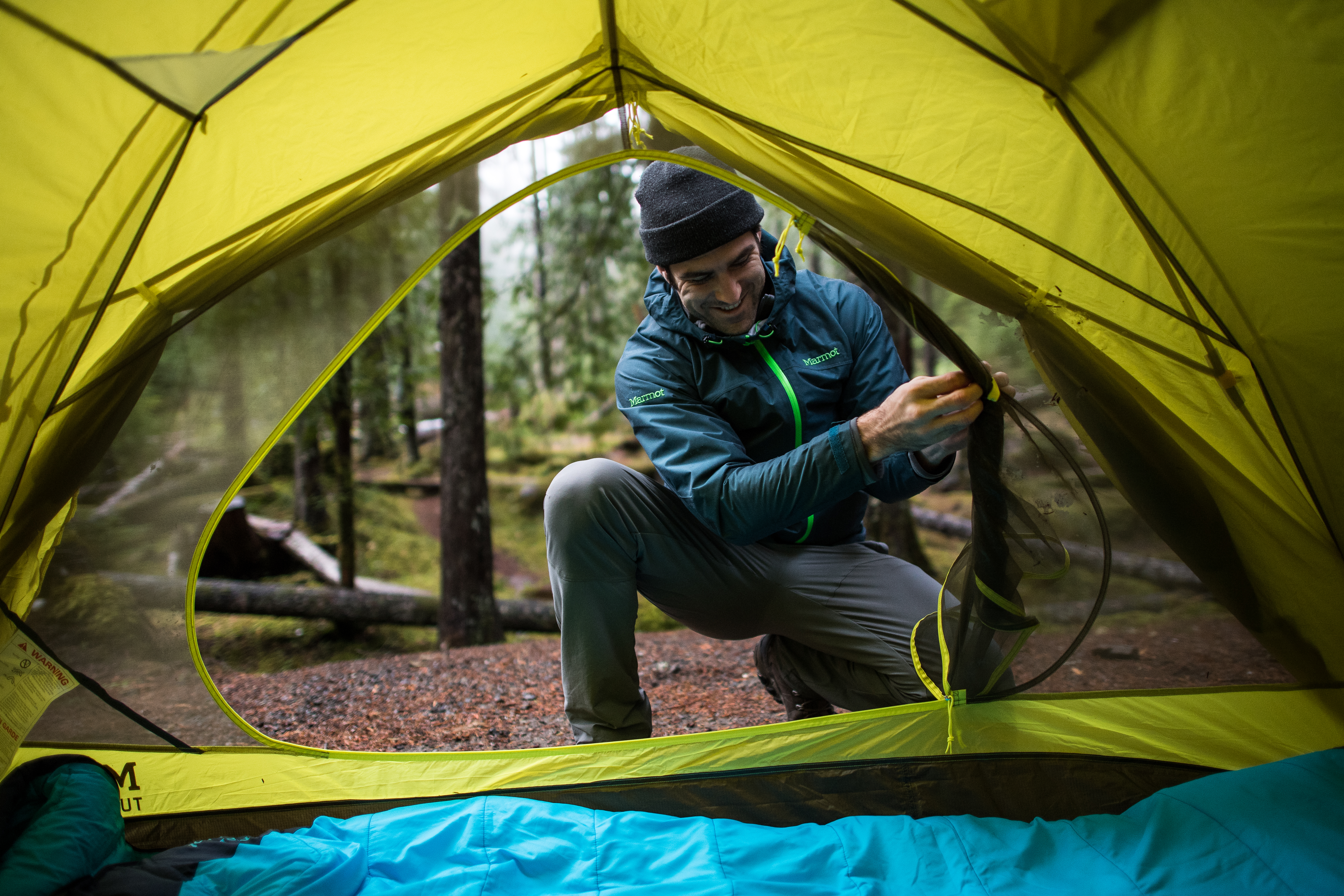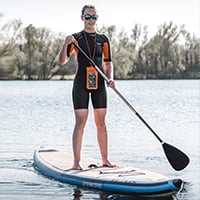
THE TENT GUIDE – THE ART OF FINDING THE RIGHT TENT
When civilisation feels overrated, many of us love to grab our tents and head off into the woods or up into the mountains. But, you’ll struggle to find a tent that fits one person for all trips. Camping enthusiasts often have more than one tent: a lightweight tent and a more robust one that can be used for different trips. However, if you know you’re only camping under clear skies during summer time, it’s easier to find one that will meet your requirements. This guide aims to help you purchase the best new wild home for you.
A few quick choices
| Tents and accessories | When to use? | Leave at home? |
|---|---|---|
| Dome tent | In terrain where pegs are hard to pitch and where strong winds may occur. | If you need the lightest tent possible. |
| Tunnel tent | You want more space for less weight. | When pegs are hard to pitch in the terrain. |
| 3-season tent | Spring, summer and autumn in mild weather. | In winter temperatures. |
| 4-season tent | Cold climates with snow and strong winds. | Summer days when you need a well ventilated inner tent. |
| Double walled tent | You want more warmth and more ventilation with less condensation. | When you want to carry light. |
| Two doors | You want comfortable camping for many people. | When you want to save on weight. |
| Footprint | To protect your tent. | When you want to save on weight. |
Dome or tunnel tent?
Dome tents are self-supporting, which means they're able to stand up using only poles. So, this is a good tent for terrain where pegs are difficult to pitch – making it a favourite among kayakers. Dome tents require a smaller surface than tunnel tents and can be easily moved around until you find the best location. The outer tent of the dome is very tight, meaning it’s less sensitive to wind direction and quieter to sleep in when there’s strong winds.
Tunnel tents require ground pegs and storm lines/guy lines to stand. The advantage of the tunnel tent is that it offers more space for less weight. The vestibule provides extra storage space. The inner and outer tent are assembled and erected at the same time – preventing the inner tent from getting wet if it’s raining when you pitch it. Tunnel tents are more sensitive to strong side winds, but if you pitch them in the direction of the wind, they provide stable protection.
Tent size
The size of your tent is a real "it depends on" subject.
Tents for two persons can be the most versatile choice, but larger tents also have their advantages. A
4-person tent weighs less per person than 2 x two-person tents so it can actually save a group some
weight. Another reason for having a bigger tent is the extra space. Although it’s not necessary for two
people to share a 3-person tent during a long hike, this extra space means a much more comfortable day
if you’re forced to sit in your tent and wait out a storm. It also provides extra elbow room at night.
For alpine tours where weight is very important, choose a tent for the exact number of users. Some
alpine climbers use tents that are too small just to save weight, at the expense of their comfort. If
you plan to have a base camp on a glacier or spend a week skiing based at the same campsite, it's well
worth considering a bigger tent than you really need.
Tent weight
The weight of the tent is an important issue for most. A practical way of thinking
about it is by weight per person. A 2-person tent weighing 3 kg equals only 1.5 kg per person. But, if
you two prefer the extra space of a 3-person tent that weighs 4 kg, it will mean 2 kg per person. Is it
worth it? Only you can decide.
Comparison between models is easier thanks to the following definitions used by most
manufacturers:
- Min. weight (minimum weight) is the total weight of only the inner tent, outer tent and poles: the most necessary components.
- Max. weight (maximum weight / packaged weight) is the total weight of all the tent parts: inner and outer tent, poles, pegs, packing bags, instructions, repair equipment and any other stuff the manufacturer sends with the tent.
3-season tents
The 3-season tent is the most popular type of tent and is suitable for spring, summer and autumn. They have well-ventilated inner tents for hot summer days and extensive outer tents that keep you dry in the rain. Double-walled 3-season tents contain plenty of ventilation options that keep the temperature down in warm weather and allow for a condensation-free environment. Single wall tents keep weight to a minimum.
4-season tents
Unsurprisingly, 4-season tents are made from stronger materials than 3-season tents; including both the outer and inner tents. In addition, the shape of the tent maximises resilience to heavy winds and snow. They should be quick to put up and have a larger vestibule to store your equipment in. All ventilation can be closed in stormy conditions and they have more storm/guy lines for anchorage. Choose a double walled tent for higher warmth and comfort as well as reduced condensation, or select a single wall version if you need to limit carried weight during hikes or rock climbs.
What do particular tent characteristics mean out in the field?
Water column The number of the water column indicates the water density in the outer tent or the floor of the inner tent. The outer tent doesn’t need to be as waterproof as the floor because water flows off the sloping roof. The floor, on the other hand, needs to be more waterproof because it may stand in water if it rains a lot and you and your equipment will press this water against the floor whilst moving around in the tent. In general, all tents have sufficient waterproofness to withstand rain as well as moisture from below, the exception may be some single-walled bivy tents intended for cold weather. What does differ however, is life expectancy and wear resistance. Waterproofing in both fabric and hardware deteriorates over time and with use, which means that a tent with a higher water column has a longer life. In most cases you’ll find tents with a water column rating of 3,000mm in the floor and 1,000mm in the outer tent, but a tent with a floor rating of over 10,000mm is of course a better investment for those who’ll use their tent longer and more regularly.
The vestibule The vestibule is a space that can be used for equipment you don’t want to enter the tent but you still want to keep dry. One example is muddy boots that you’d like to keep close, but don’t want in your clean tent. You can also always expand your tent's protection with a tarp.
Single or double wall Buy a single wall tent for trips where weight and space are your biggest concern, like long hikes and light alpine climbing trips. Pick a double-wall tent if you're going to be in rainy or hot weather – as it provides better airflow and less condensation. They're suitable for trips where you’ll be at the same campsite for several nights.
Doors How many doors you want is a discussion that ultimately always comes back to weight. Two doors are more comfortable, but they weigh more. For some, however, it may be worth a few extra hectograms for an extra door, especially for tents that hold three or more people. Even the most committed weight weenies have to admit that a second door is quite nice to have when there are more people. On a steep alpine trek, a second door only adds weight. And if you're weight sensitive; get one door. When it comes to 4-season tents, the choice of one or two doors is usually based on how much time you’re travelling or camping for.
Ventilation 3-season double-walled tents offer plenty of ventilation options that keep temperatures down in warm weather and allow for a condensation-free environment. 3-season single-wall tents have fewer ventilation possibilities, resulting in poorer airflow and higher condensation. 4-season tents usually have as much ventilation as you need to handle condensation and every surface of the mesh is sealed to keep snow out during a storm.
Footprint Long live tents with footprints! A footprint, or protective floor, offers many advantages. It protects the tent floor from wear from rocky surfaces. It adds extra water resistance and durability for long stays in a campsite. It prevents moisture and soil condensation from penetrating from below; reducing the risk of condensation inside the tent. On long journeys where weight is crucial, this protective floor is often left at home. If you don’t have to worry about saving on weight but still wonder if you should bother buying a footprint, there’s one last winning argument: It costs less than a new tent.
Take care of your tent
- Clean the tent and zippers occasionally
- Be careful with zippers and tent poles
- Check that all pole segments are inserted into each other during assembly
- Use a footprint /protective floor
- Keep dog claws away from the floor and fly sheet
- Don’t keep the tent in direct sunlight for prolonged periods as UV rays will quickly break down the fabric. Leaving your tent in the garden during summer is a sure last farewell
- Wipe the tent before storing it (allow it to become 100% dry first)
- Store in a dry and cool place

Q&A
I’ve found a tent with fibreglass poles. Can I take it into the mountains?
Fibreglass poles are usually supplied with simple tents intended for use below the tree line and in sheltered camps. Fibreglass poles won’t tolerate the same stresses or offer the same stability as aluminium poles. These tents are more suitable for beginner campers trying out sleeping outside or for campers who know they won’t be exposing the tent to bad weather. We strongly discourage using tents with fibreglass arches in a mountain environment.
What should I consider when choosing an ultralight tent?
Ultralight tents are amazing creations, but there are a few things you need to
think
about. Creating these light tents usually requires ultralight materials, reduced surfaces and less
comfort.
Ultralight materials will give you the protection you need, but you’ll need to spend more time
choosing
a campsite and pitching your tent. The materials are very durable for being so light, but you won’t
get
the same tolerance and stability that a normal tent in the same price range would offer. So, choose
your
site carefully and keep the wind direction and terrain in mind more than usual.
Saving weight by decreasing living and storage space is an unsurprising plan, but it makes it extra
important to keep track of the dimensions. An ultralight tent for two people usually won’t
accommodate
two regular sleeping pads; you’re expected instead to have tapered sleeping pads that can overlap
each
other. There are no rules about this, so all you can do is pay attention to the measurements.
Often, these smaller surface tents also contain lower ceilings, fewer storage spaces and little or
no
vestibules. This means that the comfort of an ultralight tent overall is lower or much lower than in
the
corresponding normal range. If this is a problem or not is up to you to decide, but it’s important
to
keep this in mind, especially if you want to find a light tent to use regularly. If you’re looking
for
tents for extreme races you may already have decided that comfort isn’t the most important factor in
your choice of tent.
Competition amongst brands over who has the lightest tent has also led to making weight savings on things that shouldn’t be saved on. Many manufacturers, for example, deliver ground pegs that we’d consider very expensive toothpicks. Expect to add a few extra pegs to replace less-than-practical ground pegs with something that can actually be used.
What is so special about Hilleberg tents?
There are many good tent manufacturers out there, but there are a few things that make Hilleberg the world's best tent manufacturer. All the materials used (from tear strength and waterproofness to thickness and quality of the poles) ensure that the tent will last over time. One can easily argue that the water tightness of a tent floor doesn’t need a rating of 15,000mm, but for those who use tents often, that quality will be crucial over time as the materials gradually break down.The high quality of the seams and overall design means you rarely need to send your tent off for service. And if you do require a service, Hilleberg's handling of repairs may be the easiest available and prices are low. There aren’t many tent manufacturers who receive 20-year-old tents and can still change their inner tent floors.
This doesn’t mean that we think a Hilleberg tent is always the best option for everyone. Their tents offer a low price per tent night for those who camp often, but if you’ve just started out, you may need to first find out whether you enjoy staying in a tent! There are a number of different manufacturers who produce very high-quality tents that may be the better choice for you depending on your specific needs.
































